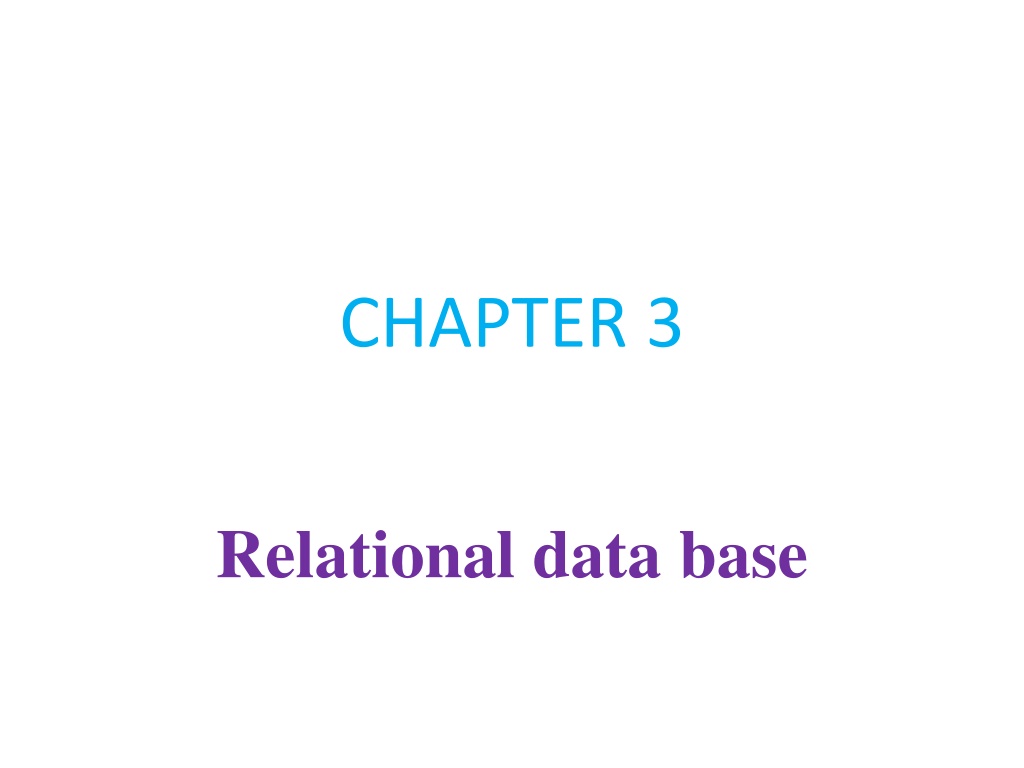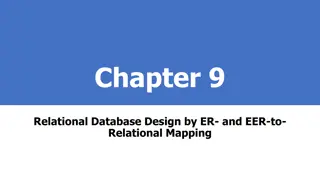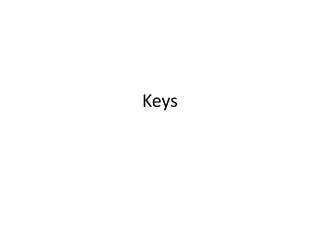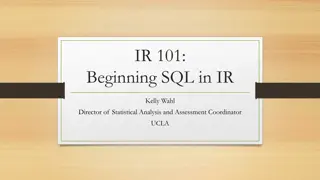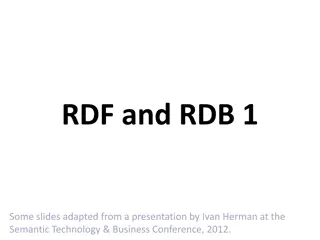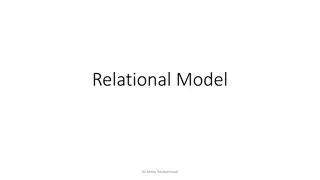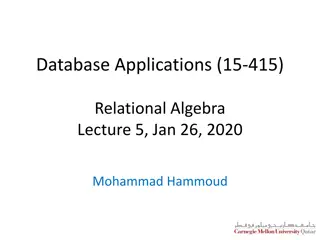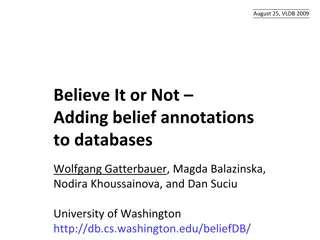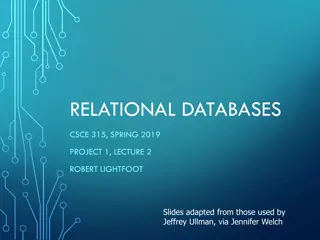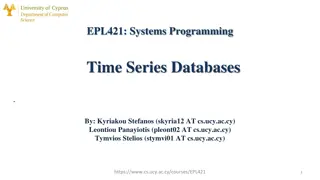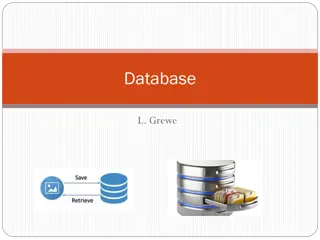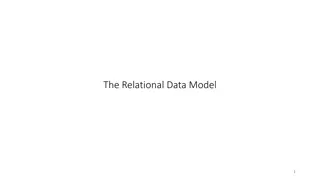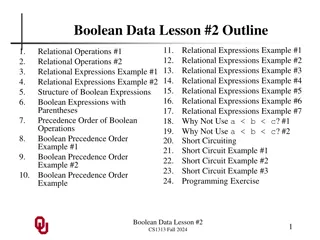Understanding Relational Databases and File-Based Systems
This chapter delves into the fundamental concepts of databases, comparing them to file-based systems, and highlighting the significance of relational databases in modern integrated AISs. It explores the difference between logical and physical views of databases, introduces key concepts such as DBMS and schemas, and explains how relational databases organize and structure data efficiently.
Download Presentation

Please find below an Image/Link to download the presentation.
The content on the website is provided AS IS for your information and personal use only. It may not be sold, licensed, or shared on other websites without obtaining consent from the author. Download presentation by click this link. If you encounter any issues during the download, it is possible that the publisher has removed the file from their server.
E N D
Presentation Transcript
CHAPTER 3 Relational data base
INTRODUCTION Questions to be addressed in this chapter: How are databases different than file-based systems? Why databases are important and what is their advantage? What is the difference between logical and physical views of a database? What are the fundamental concepts of database systems such as DBMS, schemas, the data dictionary, and DBMS languages? What is a relational database, and how does it organize data? How are tables structured to properly store data in a relational database?
INTRODUCTION Relational databases are used for most modern integrated AISs. They are the most popular type of database used for transaction processing. In this chapter, we ll define the concept of a database and relational data base.
FILE VS. DATABASES Let s examine some basic principles about how data are stored in computer systems. An entity is anything about which the organization wishes to store data. At your college or university, one entity would be the student. STUDENTS Phone Number Student ID Last Name Samson Abebe Fugge First Name Seleshe Chine Ferera Birth Date 333-33-3333 333-3333 10/11/84 111-11-1111 444-4444 11/24/86 123-45-6789 555-5555 04/20/85
FILE VS. DATABASES Information about the attributes of an entity (e.g., the student s ID number and birth date) are stored in fields. A field is the physical space where an attribute is stored. STUDENTS Phone Number Student ID Last Name Samson Abebe Fugge First Name Seleshe Chine Ferera Birth Date 333-33-3333 333-3333 10/11/84 111-11-1111 444-4444 11/24/86 123-45-6789 555-5555 04/20/85
FILE VS. DATABASES All the fields containing data about one entity (e.g., one student) form a record. The example below shows the record for Abebe Chine. STUDENTS Phone Number Student ID Last Name Samson Abebe Fugge First Name Seleshe Chine Ferera Birth Date 333-33-3333 333-3333 10/11/84 111-11-1111 444-4444 11/24/86 123-45-6789 555-5555 04/20/85
FILE VS. DATABASES A set of all related records forms a file (e.g., the student file). If this university only had three students and five fields for each student, then the entire file would be depicted below. STUDENTS Phone Number Student ID Last Name Samson Abebe Fugge First Name Seleshe Chine Ferera Birth Date 333-33-3333 333-3333 10/11/84 111-11-1111 444-4444 11/24/86 123-45-6789 555-5555 04/20/85
FILE VS. DATABASES Amaster file is a file that stores cumulative information about an organization s entities. A set of interrelated, centrally coordinated files forms a database. Student File Class File Advisor File
FILE VS. DATABASES Database systems were developed to address the problems associated with the proliferation of master files. For years, each time when a new information need arose, companies created new files and programs. The result: a significant increase in the number of master files.
FILE VS. DATABASES This proliferation of master files created problems: Often the same information was stored in multiple master files. Made it more difficult to effectively integrate data and obtain an organization-wide view of the data. Also, the same information may not have been consistent between files. e.g. If a student changed his phone number, it may have been updated in one master file but not another. Master File 1 Fact A Fact B Fact C Enrollment Program Master File 2 Fact A Fact D Fact F Fin. Aid Program Master File 3 Fact A Fact B Fact F Grades Program
FILE VS. DATABASES Database systems were developed to address the above stated problems Database Fact A Fact B Fact C Fact D Fact E Fact F Database Management System Enrollment Program Fin. Aid Program Grades Program
FILE VS. DATABASES The database approach treats data as an organizational resource that should be used by entire organization and managed for the entire organization, Data is not just a particular department. A database management system (DBMS) serves as the interface between the database and the various application programs. Database Fact A Fact B Fact C Fact D Fact E Fact F Database Management System Enrollment Program Fin. Aid Program Grades Program
FILE VS. DATABASES The combination of the database, the DBMS, and the application programs that access the database is referred to as the database system. Database Fact A Fact B Fact C Fact D Fact E Fact F Database Management System Enrollment Program Fin. Aid Program Grades Program
FILE VS. DATABASES The person responsible for the database is the database administrator. As technology improves, many large companies are developing very large databases called data warehouses. Database Fact A Fact B Fact C Fact D Fact E Fact F Database Management System Enrollment Program Fin. Aid Program Grades Program
IMPORTANCE AND ADVANTAGES OF DATABASE SYSTEMS Database technology is every where. Most new AISs implement a database approach. Virtually all mainframe computer sites use database technology. Use of databases with PCs is growing also.
IMPORTANCE AND ADVANTAGES OF DATABASE SYSTEMS As accountants, you are likely to audit or work for companies that use database technology to store, process, and report accounting transactions. Many accountants work directly with databases and will enter, process, and query databases. Some will develop and evaluate internal controls necessary to ensure database integrity. Others will be involved in the design and management of databases.
IMPORTANCE AND ADVANTAGES OF DATABASE SYSTEMS Database technology provides the following benefits to organizations: Data integration Achieved by combining master files into larger pools of data accessible by many programs.
IMPORTANCE AND ADVANTAGES OF DATABASE SYSTEMS Database technology provides the following benefits to organizations: Data integration Data sharing It s easier to share data that s integrated.
IMPORTANCE AND ADVANTAGES OF DATABASE SYSTEMS Database technology provides the following benefits to organizations: Data integration Data sharing Reporting flexibility Reports can be revised easily and generated as needed. The database can easily be browsed to research problems or obtain detailed information.
IMPORTANCE AND ADVANTAGES OF DATABASE SYSTEMS Database technology provides the following benefits to organizations: Data integration Data sharing Reporting flexibility Minimal data redundancy and inconsistencies Because data items are usually stored only once.
IMPORTANCE AND ADVANTAGES OF DATABASE SYSTEMS Database technology provides the following benefits to organizations: Data integration Data sharing Reporting flexibility Minimal data redundancy and inconsistencies
IMPORTANCE AND ADVANTAGES OF DATABASE SYSTEMS Database technology provides the following benefits to organizations: Data integration Data sharing Reporting flexibility Minimal data redundancy and inconsistencies Central management of data Data management is more efficient because the database administrator is responsible for coordinating, controlling, and managing data.
IMPORTANCE AND ADVANTAGES OF DATABASE SYSTEMS Database technology provides the following benefits to organizations: Data integration Data sharing Reporting flexibility Minimal data redundancy and inconsistencies Central management of data Cross-functional analysis Relationships can be explicitly defined and used in the preparation of management reports. EXAMPLE: Relationship between selling costs and promotional campaigns.
DATABASE SYSTEMS Logical and Physical Views of Data In file-oriented systems, programmers must know the physical location and layout of records used by a program. They must reference the location, length, and format of every field they utilize. When data is used from several files, this process becomes more complex.
DATABASE SYSTEMS Database systems overcome this problem by separating the storage and use of data elements. Two separate views of the data are provided: Logical view How the user or programmer conceptually organizes and understands the data.
DATABASE SYSTEMS Database systems overcome this problem by separating the storage and use of data elements. Two separate views of the data are provided: Logical view Physical view How and where the data are physically arranged and stored.
DATABASE SYSTEMS Database systems overcome this problem by separating the storage and use of data elements. Two separate views of the data are provided: Logical view Physical view Separating these views facilitates application development, because programmers can focus on coding the logic and not be concerned with storage details.
Logical ViewUser B Logical View User A Scholarship Distribution Fr. 5% Sr. 33% Enrollment by Class Soph. 24% Jr. 38% The DBMS translates users logical views into instructions as to which data should be retrieved from the database. DBMS Operating System Database
Logical ViewUser B Logical View User A Scholarship Distribution Fr. 5% Sr. 33% Enrollment by Class Soph. 24% Jr. 38% The operating system translates DBMS requests into instructions to physically retrieve data from various disks. DBMS Operating System Database
DATABASE SYSTEMS The DBMS handles the link between the physical and logical views of the data. Allows the user to access, query, and update data without reference to how or where it is physically stored. The user only needs to define the logical data requirements.
DATABASE SYSTEMS Separating the logical and physical views of data also means users can change their conceptualizations of the data relationships without making changes in the physical storage. The database administrator can also change the physical storage of the data without affecting users or application programs.
DATABASE SYSTEMS Schemas A schema describes the logical structure of a database. There are three levels of schema. Conceptual level schema The organization-wide view of the entire database i.e., the big picture. Lists all data elements and the relationships between them.
DATABASE SYSTEMS Schemas A schema describes the logical structure of a database. There are three levels of schema. Conceptual level schema External level schema A set of individual user views of portions of the database, i.e., how each user sees the portion of the system with which he interacts. These individual views are referred to as subschema.
DATABASE SYSTEMS Schemas A schema describes the logical structure of a database. There are three levels of schema. Conceptual level schema External level schema Internal level schema A low-level view of the database. Includes specific elements: Record layouts Definitions Addresses Indexes
DATABASE SYSTEMS Accountants are frequently involved in developing conceptual- and external-level schema. An employee s access to data should be limited to the subschema of data that is relevant to the performance of his job.
DATABASE SYSTEMS The Data Dictionary A key component of a DBMS is the data dictionary. Contains information about the structure of the database. For each data element, there is a corresponding record in the data dictionary describing that element.
DATABASE SYSTEMS Information provided for each element includes: A description or explanation of the element. The records in which it is contained. Its source. The length and type of the field in which it is stored. The programs in which it is used. The outputs in which it is contained. The authorized users of the element. Other names for the element.
DATABASE SYSTEMS Accountants development of the data dictionary because they have a good understanding of the data elements in a business organization, as well as where those elements originate and how they are used. should participate in the
DATABASE SYSTEMS The DBMS usually maintains the data dictionary. It is often one of the first applications of a newly implemented database system. Inputs to the dictionary include: Records of new or deleted data elements. Changes in names, descriptions, or uses of existing elements. Outputs include: Reports that are useful to programmers, database designers, and AIS users.
DATABASE SYSTEMS DBMS Languages Every DBMS must provide a means of performing the three basic functions of: Creating a database Changing a database Querying a database
DATABASE SYSTEMS DBMS Languages Every DBMS must provide a means of performing the three basic functions of: Creating a database Changing a database Querying a database
DATABASE SYSTEMS Creating a database: The set of commands used to create the database is known as data definition language (DDL). DDL is used to: Build the data dictionary Initialize or create the database Describe the logical views for each individual user or programmer Specify any limitations or constraints on security imposed on database records or fields
DATABASE SYSTEMS DBMS Languages Every DBMS must provide a means of performing the three basic functions of: Creating a database Changing a database Querying a database
DATABASE SYSTEMS Changing a database The set of commands used to change the database is known as data manipulation language (DML). DML is used for maintaining the data including: Updating data Inserting data Deleting portions of the database
DATABASE SYSTEMS DBMS Languages Every DBMS must provide a means of performing the three basic functions of: Creating a database Changing a database Querying a database
DATABASE SYSTEMS Querying a database: The set of commands used to query the database is known as data query language (DQL). DQL is used to interrogate the database, including: Retrieving records Sorting records Ordering records Presenting subsets of the database The DQL usually contains easy-to-use, powerful commands that enable users to satisfy their own information needs.
DATABASE SYSTEMS Report Writer Many DBMS packages also include a report writer, a language that simplifies the creation of reports. Users typically specify: What elements they want printed How the report should be formatted The report writer then: Searches the database Extracts specified data Prints them out according to specified format
DATABASE SYSTEMS Users typically have access to both DQL and report writer. Access to DDL and DML are typically restricted to employees with administrative and programming responsibilities.
RELATIONAL DATABASES DBMS is characterized by the type of logical data model on which it is based. A data model is an abstract representation of the contents of a database. Most new DBMSs are called relational databases because they use the relational data model developed by E.F. Codd in 1970.
RELATIONAL DATABASES The relational data model represents everything in the database as being stored in the forms of tables (aka, relations).
